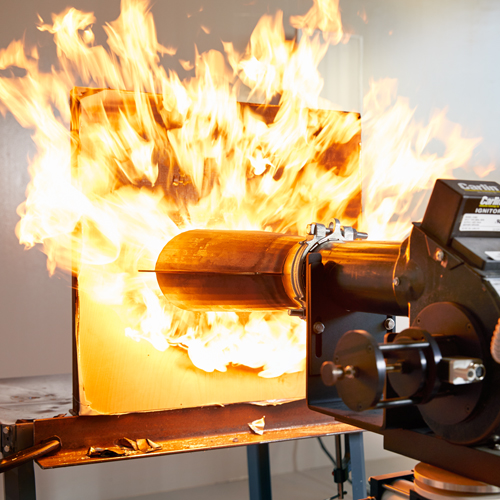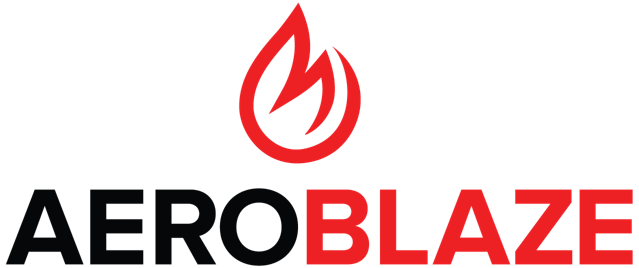Powerplant Fire Penetration
Powerplant Fire Penetration Test (for aviation)
The Powerplant Fire Penetration test is used to determine the capability of components and constructions to control the passage of fire in powerplant (engine) compartments. It is most commonly used to show compliance with "fire resistant" and "fireproof" requirements as defined in 14 CFR 1.1.
Test Methods

Test Summary
A test sample is exposed to a high-intensity 2,000°F open flame for 5 minutes (fire resistant) or 15 minutes (fireproof). The pass/fail criteria for panels are based on flame penetration and backside burning. The pass/fail criteria for other components and equipment are based on continued operation after flame application.
Test Sample Requirements
Test samples must meet the following requirements:
Regulatory Requirements
This test is typically used to show compliance with the following U.S. Federal Regulations:
Note 1: In the aviation industry, 14 CFR may also be referred to as "FAR" (Federal Aviation Regulations). You may see the requirements listed as FAR 23.1182, FAR 23.1191, FAR 25.1182, FAR 25.1191, etc.
Note 2: The European Union Aviation Safety Agency (EASA) uses similar Certification Specifications (CS) which correspond to those in the CFR. For example, the EASA regulations are listed as CS 23.1182, CS 25.1191, etc. These regulations may also be referred to as "JAR" (Joint Aviation Requirements) and listed as JAR 23.1182, JAR 25.1191, etc.
Products Requiring This Test
The following products typically require the Powerplant Fire Penetration test.
History of the Powerplant Fire Penetration Test
In 1947, the U.S. Civil Air Authority (CAA) issued Safety Regulation Release (SRR) No. 259 to provide approved test methods to be used in demonstrating compliance with fire and flammability requirements. Flight Standards Service Release (FSSR) No. 453 superseded SRR No. 259 in 1961 pending incorporation of appropriate test procedure in the Civil Aeronatuics Manuals. Both the SRR and FSSR releases contained a fireproof test and two different types of fire-resistant tests, among others. In 1961, the CAA issued Power Plant Engineering Report No. 3, which provided a standard burner and other equipment to test hose assemblies under simulated conditions. The test aimed at producing a typical aircraft powerplant fire, with similar vibration, fluid flow, pressure, and temperature as would be encountered during rough engine operation. The Federal Aviation Administration (FAA), which was established in 1965 to replace the CAA, revisited and revised this test method to Power Plant Engineering Report No. 3A.
Since the issuance of the Civil Air Regulations in 1946 and the superseding federal regulations in 1962, the fire safety requirements were defined with the terms "fire resistant" and "fireproof" as follows:
Fire-resistant (per 14 CFR 1.1) —
(1) With respect to sheet or structural members, means the capacity to withstand the heat associated with fire at least as well as aluminum alloy in dimensions appropriate for the purpose for which they are used; and
(2) With respect to fluid-carrying lines, fluid system parts, wiring, air ducts, fittings, and powerplant controls, means the capacity to perform the intended functions under the heat and other conditions likely to occur when there is a fire at the place concerned.
Fireproof (per 14 CFR 1.1) —
(1) With respect to materials and parts used to confine fire in a designated fire zone, means the capacity to withstand at least as well as steel in dimensions appropriate for the purpose for which they are used, the heat produced when there is a severe fire of extended duration in that zone; and
(2) With respect to other materials and parts, means the capacity to withstand the heat associated with fire at least as well as steel in dimensions appropriate for the purpose for which they are used.
One problem with these definitions is that they do not specify heat intensity, temperature levels, duration, or an appropriate wall thickness for the purpose intended. In order to simplify the requirements, the FAA issued Advisory Circular AC 20-135 in 1990 to provide guidance to manufacturers on demonstrating compliance with the powerplant fire protection regulations. This advisory circular includes methods and rationale for fire testing of various equipment. For the purpose of AC 20-135, the terms "fire resistant" and "fire proof" were defined as follows:
Fire-resistant (per AC 20-135) —
When applied to powerplant installations such as fluid-carrying lines, flammable fluid system components, wiring, air ducts, fittings and powerplant controls, “fire resistant” means the capability of a material or component to perform its intended functions under the heat and other conditions likely to occur at the particular location and to withstand a 2000°F flame (±150°F) for 5 minutes minimum.
Fireproof (per AC 20-135) —
The capability of a material or component to withstand, as well as or better than steel, a 2000°F flame (±150°F) for 15 minutes minimum while still fulfilling its design purpose. The term “fireproof”, when applied to materials and parts used to confine fires within designated fire zones, means that the material or part will perform this function under conditions likely to occur in such zones and will withstand a 2000°F flame (±150°F) for 15 minutes minimum.
AC 20-135 also specifies a burner and flame condition to standardize the test. The burner types allowed are specified in Powerplant Engineering Report No. 3A. These kerosene burners must produce a 2000°F temperature within 1/4-inch of the specimen and engulf or provide representative impingement coverage, dependent on the specimen size. In addition, the burner must provide a heat flux density of at least 9.3 BTU/ft2-sec using a calorimeter or 4500 BTU/hr using the BTU Heat Transfer Device. Propane burners are no longer acceptable for use in AC 20-135 testing.
The Powerplant Fire Penetration test underwent a few changes since its creation in 1947. Individual manufacturers and organizations also established their own internal versions of the Powerplant Fire Penetration test, such as Boeing (BSS 7338), RTCA (DO-160), and International Organization for Standardization (ISO 2685).
In order to facilitate improvements to the test standard without constantly changing the CFR, the FAA published Report DOT/FAA/CT-99/15 "Aircraft Materials Fire Test Handbook" in 1990. The handbook was updated in 2000 to DOT/FAA/AR-00/12, with the Powerplant Fire Penetration tests located in Chapters 11 and 12 of the handbook. These test methods are not typically an acceptable method for showing compliance with the regulations. To show compliance with federal regulations, the requirements of Advisory Circulars AC 20-135 or AC 33.17-1 should be followed.
Sources: FAA Fire Test Handbook
Additional Resources
| Resource | Description |
|---|---|
| 14 CFR 23 |
Airworthiness Standards: Normal, Utility, Acrobatic, and Commuter Category Airplanes U.S. Regulations for FAR 23. (Historical) |
| 14 CFR 25 |
Airworthiness Standards: Transport Category Airplanes U.S. Regulations for FAR 25. |
| 14 CFR 27 |
Airworthiness Standards: Normal Category Rotorcraft U.S. Regulations for FAR 27. |
| 14 CFR 29 |
Airworthiness Standards: Transport Category Rotorcraft U.S. Regulations for FAR 29. |
| 14 CFR 33.17 |
Fire Protection Airworthiness Standards: Aircraft Engines U.S. Regulations for FAR 33. |
|
FAA Fire Test Handbook, Chapter 11 |
FAA Aircraft Materials Fire Test Handbook (DOT/FAA/AR-00/12); Chapter 11; Powerplant Hose Assemblies Test. This handbook provides a test method which is not a currently acceptable means of compliance with the relevant regulations. |
|
FAA Fire Test Handbook, Chapter 12 |
FAA Aircraft Materials Fire Test Handbook (DOT/FAA/AR-00/12); Chapter 12; Powerplant Fire Penetration Test. This handbook provides a test method which is not a currently acceptable means of compliance with the relevant regulations. |
|
FAA Advisory Circular AC 20-135 |
Powerplant Installation and Propulsion System Component Fire Protection Test Methods, Standards and Criteria Provides guidance for use in demonstrating compliance with the powerplant fire protection requirements of the Federal Aviation Regulations (FAR). Included in this document are methods for fire testing of materials and components used in the propulsion engines and APU installations, and in areas adjacent to designated fire zones, as well as the rationale for these methods. |
|
FAA Advisory Circular AC 33.17-1A |
Engine Fire Protection Provides definitions, guidance, and acceptable methods, but not the only methods, that may be used to demonstrate compliance with the engine fire protection requirements of Title 14 Code of Federal Regulations (14 CFR 33.17). The guidance provided in this AC supersedes information contained in AC 33-2B titled "Aircraft Engine Type Certification Handbook" (Chapter 3, Section 22, titled "Section 33.17, Fire Prevention"). |
Ask the Experts

Stuck? Our experts will help you determine the best solution for your needs.
Contact Us